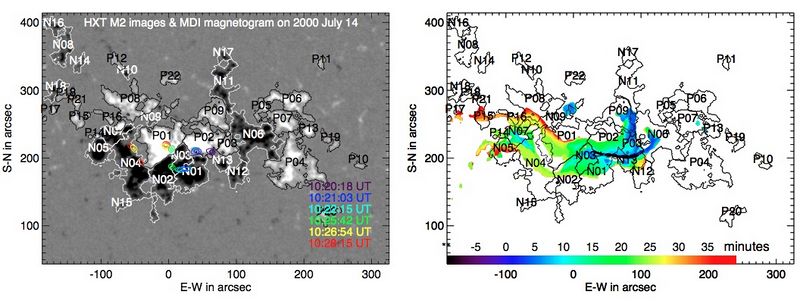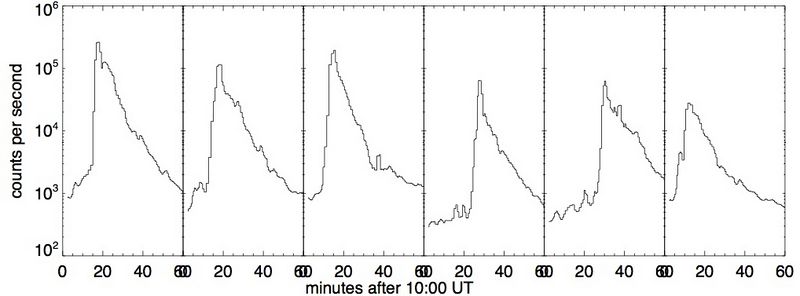User talk:Jiongqiu
From RHESSI Wiki
| Nugget | |
|---|---|
| Number: | ??? |
| 1st Author: | Jiong Qiu |
| 2nd Author: | |
| Published: | 2013 January |
| Next Nugget: | Albedo and the modification of RHESSI results |
| Previous Nugget: | Awesome Stellar Flare Spectra |
| List all | |
Contents |
Introduction
Solar flares are characterized by impulsively enhanced emissions most pronounced in hard X-ray and microwave light curves. These light curves in even a simple, single, short-lived flare usually exhibit quite complicated structures consisting of numerous fast-varying bursts, unlike the rather smooth and gradual soft X-ray emissions. Ground-based and space missions in pre-RHESSI era have revealed the shortest time scales, from a few seconds to several tens of milli-seconds, of these bursts. A few studies correlating high cadence yet spatially unresolved hard X-ray observations with high cadence high resolution optical observations have further shown that hard X-ray bursts are correlated with optical emission on time scales of about one second, suggesting that these fast-varying bursts are thick-target emissions, and their size is within one arc-second. This is, in general, consistent with recent EUV observations showing that the size of a flare loop is about one arc-second. It may be noted that these quoted values are likely upper bounds of the tempo-spatial scales as limited by the resolving capability of instruments.
Today we commonly recognize that a flare is a collection of multiple episodes of energy release on some fundamental scales. For example, the bursts' time scales may depend on the characteristic size of the elementary flux tubes (e.g., Sturrock et al. , 1984; LaRosa & Moore , 1993), or the turbulent dynamics of the reconnecting current sheets (eg., Litvinenko , 1996). As these fast-varying bursts are typically reported in hard X-ray and microwave light curves, the observed time scales are also a product of convolution with timescales of acceleration and transport of non-thermal particles in flare environment.
The Reuven Ramaty High Energy Solar Spectroscopic Imager (RHESSI Lin et al. , 2002) launched in early 2002 has unprecedented resolution to investigate the temporal, spectral and spatial properties of hard X-ray spikes. This nugget studies hard X-ray bursts observed by RHESS in 2002. The questions raised by these spikes are: are they the fundamental structure of flare energy release? Are flare spectral properties related to their time spatial scales?
How Many Hard X-ray Spikes, How fast, How small
Turns out only a small fractions of flares exhibit these spikes that can be detected at up to 100 keV. They have rather symmetric rise and decay; about one third of spikes show high energy emission lagging low energy emission, and the spectrally, the spikes have slightly harder spectrum than underlying component. Therefore, the spikes are a special kind of energetic burst, but not the building blocks of flare emission in general. However, with the present

Discovery of UV "cooling"
Generally, and in this case as well, the hard X-ray and UV emissions have strikingly similar time variations when viewed as a whole, but in detail they may not agree. The UV emission persists at low levels, filling out the ribbon structures even when the hard X-ray footpoints have disappeared or moved elsewhere. We have studied the time variation in individual pixels of the TRACE images and find a very suggestive pattern, which we illustrate in Figure 2.
The individual pixels show a characteristic pattern. At the beginning, there is an impulsive increase; following this, each pixel appears to decay exponentially in brightness. We suggest that the UV emission, which rises nearly instantaneously with the hard X-rays, is likely produced primarily by non-thermal electron precipitation, and then undergoes an elongated decay well after the decay of hard X-rays. This could be identified with the cooling (or loss of excess energy in the form of gas pressure) of magnetic loops formed as a part of the flare arcade. The tendency for individual loops to have similar decay times would then correspond to the fact that the loops have similar dimensions.
Conclusions
The revisit raises some interesting questions. First, obviously, the evolution and mapping of UV and hard X-ray sources reflect the pattern of magnetic reconnection which is not entirely 2-dimensional, and second, the coincident rise and peak but delayed decay in UV emission with respect to hard X-ray emission suggests some different physics, not directly related to hard X-ray producing process, taking place during the gradual decay of UV emission.
We think that an individual point in the ribbon stays bright, even after its initial excitation (identified with the hard X-ray footpoint) has faded away. The persistence of this UV brightness allows the ribbons to have a larger extent than the footpoints, and to follow a different pattern of evolution.
Acknowledgements
This Nugget is based on a presentation at the recent Solar Physics Division meeting by the author with Wenjuan Liu, Nicholas Hill, and Maria Kazachenko.
[Category: Nugget]]
